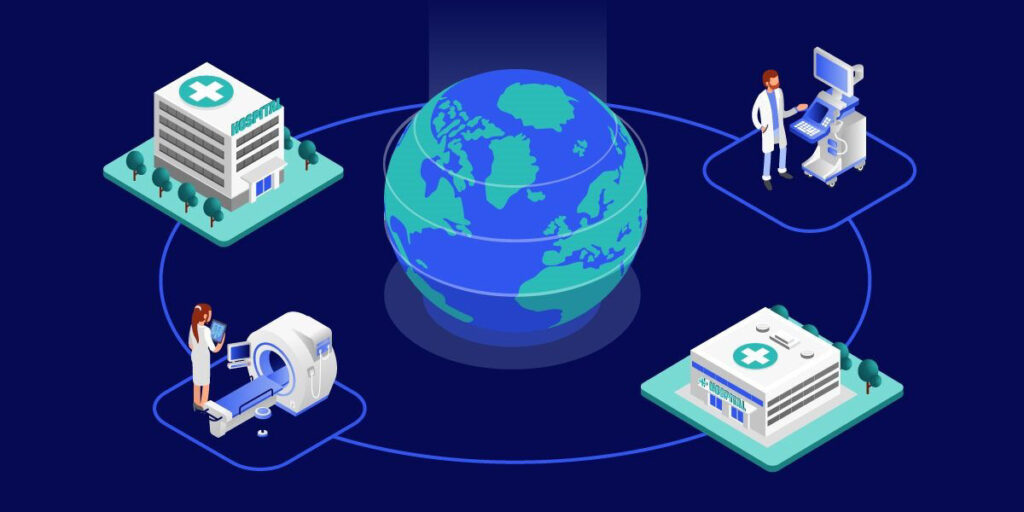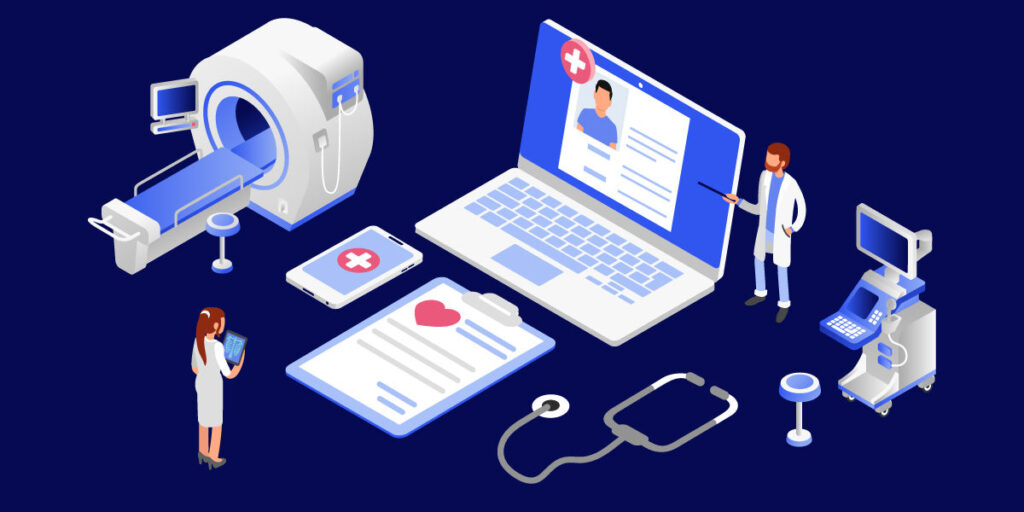Healthcare institutions wrestle with a multitude of challenges that impact both patient outcomes and staff efficiency, from staff shortages to inefficient workflows. Over 49% of medical professionals report burnout, and administrative inefficiencies can result in delayed patient care, increased costs, and compromised safety.
Many clinics, GP surgeries, and hospitals in the UK face a serious shortfall in the number of specialists, especially in rural and underserved areas. Hospital staff frequently struggle with excessive paperwork, delayed access to patient records, and fragmented communication. With over 125,000 vacancies in hospital and community health services in England alone, efficiency is paramount.
AI/AR-powered smart glasses with secure remote collaboration is emerging as a groundbreaking solution, providing hands-free access to vital data, streamlining communication, and enhancing diagnostics—all while improving efficiency and patient outcomes.
1. Staff Shortages and Workforce Pressure
The NHS and private healthcare providers face chronic staff shortages, with high workloads leading to burnout, particularly among doctors, nurses, and support staff. This affects the ability to deliver timely care and increases errors due to fatigue.
- Remote Expert Guidance: AR smart glasses enable less experienced staff or trainees to receive real-time guidance from senior clinicians remotely. For example, a nurse in a rural clinic can wear AR glasses to connect with a consultant in a major hospital, receiving step-by-step instructions during procedures.
- Training and Upskilling: AR smart glasses can provide immersive, hands-free training modules, allowing staff to learn on the job without needing in-person trainers, reducing the burden on senior staff.
- Task Automation: AR glasses can display checklists or protocols, reducing cognitive load and enabling staff to focus on patient care rather than administrative tasks.
2. Access to Specialist Expertise in Remote or Underserved Areas
Patients in rural areas or smaller clinics often lack access to specialists, leading to long waiting times for consultations or unnecessary hospital transfers. This is a significant issue in the UK as well, where healthcare resources are concentrated in urban centres.
- Telemedicine Enhancement: AR smart glasses enable specialists to virtually “see” through the eyes of on-site clinicians, providing real-time diagnostic support or surgical guidance. For example, a dermatologist can guide a GP through a skin examination using AR overlays to highlight areas of concern.
- Reduced Patient Transfers: Remote collaboration allows complex cases to be managed locally, reducing the need for patients to travel to tertiary care centres and alleviating pressure on bed availability. This also reduces the inconvenience, travel and waiting time for the patients as well as saving money on transportation.
- Collaboration of Multidisciplinary Teams (MDTs): AR smart glasses facilitate virtual MDT meetings where specialists from different locations can review patient data, imaging, or live feeds, improving decision-making without requiring physical presence. For example, a paramedic in a remote area can use AR glasses to share live visuals with an A&E consultant, enabling faster triage and treatment decisions.
3. Training and Retention of Healthcare Professionals
Continuous professional development (CPD) is challenging due to time constraints, and poor work-life balance contributes to staff turnover. NHS staff surveys and reports by authorities like the Care Quality Commission have consistently highlighted that many staff feel overwhelmed to the point of either having already left or considering an exit if working conditions do not improve. Whilst the implementation of AR enabled smart glasses and secure remote collaboration solutions can substantially enhance the working conditions, they can also ensure more staff are trained and retained.
- Immersive Simulation Training: AR smart glasses can simulate clinical scenarios (e.g., emergency response or rare procedures) without requiring physical simulation suites, making training more accessible.
- Flexible Remote Learning: Clinicians can participate in virtual workshops or observe live procedures remotely, reducing time away from clinical duties. For example, a junior doctor can use AR glasses to virtually “scrub in” to a complex procedure led by a consultant, gaining experience without leaving their base hospital.
- Mentorship and Support: Remote collaboration fosters ongoing mentorship, improving job satisfaction and retention by connecting junior staff with experienced colleagues.
4. Overcrowded Facilities, Inefficient Resource Usage and Workflow Bottlenecks
Beyond frontline medical professionals, administrators face increasing challenges in optimising hospital workflows and reducing inefficiencies. 42% of healthcare leaders cite inadequate staffing and coordination as top concerns, often leading to mismanagement of resources and delayed treatment. Hospitals and clinics also often face inefficiencies in resource allocation, such as overstretched diagnostic equipment, or poorly coordinated care pathways.
- Remote collaboration can streamline workflows by enabling virtual consultations and reducing unnecessary hospital referrals. For example, a local GP or nurse can quickly confer with specialists via smart glasses, which not only accelerates decision-making but also optimises the use of in-hospital resources, easing congestion and enhancing operational efficiency. Or a hospital trust can use AR smart glasses to enable a single radiologist to oversee imaging procedures across multiple sites, optimising scanner usage.
- Coordinated Care Pathways: Remote collaboration tools allow seamless communication between primary, secondary, and tertiary care providers, reducing duplication of tests and improving resource allocation.
- Remote Maintenance of Equipment: AR smart glasses can guide on-site technicians through equipment repairs with remote expert input, reducing downtime for critical devices like MRI scanners.
5. Patient Safety and Error Reduction
Effective patient care often hinges on timely and accurate decisions. Traditional methods sometimes force clinicians to rely on fragmented data sources or wait for external consultations, which can delay interventions. While medical errors, such as misdiagnosis, medication mistakes, or procedural errors, remain a concern due to high workloads, fatigue, and complex patient cases. This can all result to threaten patient safety and increase the already significant financial strain on hospitals.
- Standardised Procedures: AR smart glasses can guide clinicians through checklists or protocols (e.g., WHO surgical safety checklist), ensuring compliance and reducing variability in care delivery.
- Real-Time Decision Support: AR smart glasses can display patient data, clinical guidelines, or AI-driven alerts during examinations or surgeries, reducing errors. For instance, medication dosages or allergies can be overlaid in real-time.
- Remote Second Opinions: Through remote collaboration, clinicians can consult specialists instantly during critical procedures, ensuring accurate decision-making under pressure. For example, during a complex surgery, AR smart glasses can overlay a digital checklist and allow a remote anaesthetist to monitor vital signs, reducing the risk of complications.
6. Long Waiting Times and Backlogs
The NHS faces significant backlogs for diagnostic procedures, outpatient appointments, and elective surgeries, exacerbated by high patient influxes that lead to overcrowded wards and long waiting times.
- Diagnostic Efficiency: AR smart glasses can assist in rapid interpretation of imaging or test results by overlaying AI-driven insights or enabling remote radiologist input, speeding up diagnosis and treatment planning.
- Streamlined Surgical Procedures: AR smart glasses can provide surgeons with real-time overlays of patient anatomy (e.g., from MRI/CT scans), improving precision and reducing operative time. Remote collaboration allows experienced surgeons to guide less experienced colleagues, increasing throughput. For example A hospital can use AR glasses to enable a senior surgeon to remotely guide multiple procedures across different sites, reducing waiting times for elective surgeries.
- Pre- and Post-Operative Remote Consultations: AR-enabled remote consultations allow specialists to assess patients pre-surgery or monitor recovery post-surgery, reducing the need for in-person visits and freeing up clinic capacity.
7. Infection Control and Minimising Physical Contact
Infection control remains critical, particularly in light of pandemics and hospital-acquired infections, requiring minimal unnecessary staff-patient interactions.
- Reduced On-Site Presence: AR glasses allow specialists to consult remotely, reducing the number of staff physically present in high-risk areas like isolation wards.
- Hands-Free Operation: Voice-controlled AR glasses minimise the need to touch surfaces, reducing contamination risks during procedures.
- Remote Patient Monitoring: AR can overlay real-time data from wearable devices, allowing clinicians to monitor patients without frequent bedside visits. For example in an ICU, AR smart glasses can enable a consultant to review patient vitals and guide treatment remotely, minimising exposure to infectious diseases.
8. Health Inequalities and Access to Care
Disparities in healthcare access persist, particularly for elderly, disabled, or socioeconomically disadvantaged patients who struggle to attend appointments.
- Home-Based Care Support: AR smart glasses can enable community nurses to perform complex assessments at patients’ homes with remote specialist input, improving access for immobile patients. For example, a community nurse visiting an elderly patient can use AR glasses to consult a geriatrician, ensuring high-quality care without hospital admission.
- Language and Accessibility Support: AR can overlay real-time translations or visual aids, improving communication with non-English-speaking or visually impaired patients.
- Outreach Clinics: AR-enabled mobile clinics can bring advanced diagnostics to underserved areas, with remote specialists supporting on-site staff.
9. Cost Savings Through Operational Efficiency
One of the biggest financial challenges in healthcare is inefficiency in workflow management. Administrative errors cost hospitals millions annually, and staff shortages lead to delays in patient care and increased labor costs. AI-powered smart glasses streamline operations by reducing paperwork, automating data retrieval, and enabling hands-free access to patient records. This results in faster decision-making, reduced errors, and optimised resource allocation, ultimately lowering operational costs.


The Future of Healthcare is Now.
By addressing staff shortages, workflow inefficiencies, and operational bottlenecks, AI and AR-powered smart glasses and remote collaboration is transforming healthcare. These solutions reduce errors, enhance productivity, and improve patient engagement, ensuring that hospitals, research institutions, and care providers stay ahead in an industry that cries out for efficiency and precision. As advancements in AI and AR continue, smart glasses and remote collaboration will become essential tools in modern healthcare, driving long term cost-effective and scalable solutions, better use of resources and most importantly greatly improved patient care.
Are you ready to explore how AI/AR enabled smart glasses and secure remote collaboration can help your healthcare organisation? CyberPlus merges decades of accredited information and cybersecurity expertise with experience in the healthcare industry, together with leading edge innovation from strategic partners such as TeamViewer and RealWear. Contact us today to discover more.

